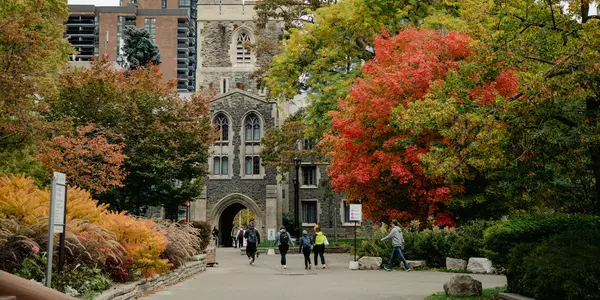Principal Investigator: Dan Breznitz
Innovation can promote economic growth and social and cultural well-being. However, innovation is often conceived and implemented in a way that leads to unequal distribution of its benefits. This program takes a multidisciplinary and cross-national look at how, why, and when the benefits of innovation aren’t always broadly shared.
The benefits of innovation tend to be concentrated in a limited number of industries, regions and hands. Innovation that exacerbates – rather than reduces – inequality can undermine public support for science and innovation and contribute to broader political alienation.
The program examines how the policies used to generate and diffuse innovation affect the distribution of opportunities and outcomes in society. It also looks at which institutions and other factors facilitate or impede the development and implementation of distribution-sensitive innovation policies, programs and practices.
The program will develop knowledge that can be used to design and implement innovation policies, programs and practices that support equitable economic growth and fair distribution around the globe.
Taking innovation to the neighbourhood: the effect of micro-geographical proximity on innovation and inter-organizational relationships
Principal Investigators: Shiri Breznitz and David Doloreux
Geographical proximity for innovation and establishment of knowledge transfer relationships in metropolitan areas is well documented in the literature, and a wide stream of research identified the importance of geography in organizing and supporting innovation (Boschma, 2005; Torre and Rallet, 2008; Ballant et al., 2015). Most of the research on industrial clusters and agglomeration economies has assumed that the patterns forged by co-location in a metropolitan area apply uniformly within that space (Delgado, 2020). Thus, most of the research has adopted a macro-level perspective and has assumed that innovation and the exchange of knowledge in urban areas occur primarily, with actors located within the same local or regional boundaries, such as a metropolitan region or city, within a cluster or regional innovation system (Fritsch and Wyrwich, 2021; Florida et al., 2017).
As stressed by Roche (2020: 912) ‘cities and their neighborhoods vary in size and scope, their densities of activities and amenities, and the manner in which they facilitate or impede the movement of individuals’. Consequently, much less attention has been dedicated to intra-metropolitan dynamics despite recent studies emphasizing their importance to understand innovation and knowledge interactions within cities (Ferretti et al., 2022; Rammer et al., 2020).
With this project, our objective is to analyse how innovation is configured and shaped within a city, or what we call the micro-geography of innovation. In this context, the micro-geography of innovation refers to the analysis of organisations and configurations of innovation at a very fine level, typically focusing on specific neighborhoods within the city. It involves examining the factors and conditions that contribute to the creation and diffusion of new ideas and technologies within a particular neighborhood, as well as the potential effects of micro-geographical proximity on interactions between different actors withing these areas.
This project includes case studies from Montreal and Toronto. In phase one, interviews were conducted in the neighborhoods of Mile End and Chabanel in Montreal. In stage two we take empirical evidence from two neighborhoods in Toronto, namely the Annex and the Junction-Triangle.
Principal investigator: Shiri M. Breznitz
The primary goal of the Alumni Impact Survey (AIS) was to evaluate the impact made by University of Toronto graduates. To achieve this goal, the university engaged in a research project in which we collected high quality survey data on key aspects of the impact of U of T alumni, including measures of social, cultural and economic impact. This project was reviewed and approved by the University of Toronto Research Ethics Board.The project was carried out under the direction of principal investigators, Professor Vivek Goel, Vice-President Research and Innovation, and Professor Shiri M. Breznitz, of the Munk School of Global Affairs, and an Alumni Impact Steering Committee of senior University staff.
Data from the survey and additional surveys conducted by Breznitz and Zhang were used in multiple research projects.
Digital Mobilities Lab
Principal Investigators: Shauna Brail and Betsy Donald
Mobility is essential to urban life. It contributes to people’s ability to access work, food, education, leisure and more. Over the past decade, innovation in digital technologies has resulted in significant disruption in urban mobilities. Emerging mobility technologies, such as ride hailing, have the potential to transform how people move in cities, how mobilities are regulated and governed, and whether emerging mobility technologies contribute to, or detract from, urban economic vibrancy.
The Digital Mobilities Lab, funded by SSHRC, explores the geographies of digital mobilities, the platform economy and cities. The project aims to develop scholarship as well as create policy and regulatory insights for governments, urban policy think-tanks, and transportation institutes. It is a research network of scholars, government and industry collaborators, and students working to better understand the possibilities, impacts, and future-state of mobile technologies and urban transportation across Canadian cities. At the Digital Mobilities Lab, our goal is to build scholarship, advance knowledge and offer policy solutions that address the realities of the emerging platform economy in Canadian cities. Leveraging the strengths of a multidisciplinary teams, the Digital Mobilities Lab i working to better understand the possibilities, impacts, and future state of mobile technologies and urban transportation across Canadian cities.
Spatial Inequality and Disruptive Innovation
Principal Investigator: Tom Kemeny
In many high-income countries over the last half-century, economic opportunity has become increasingly spatially selective. Big ‘superstar’ cities are attracting talent and high-income work, while other regions are falling behind. Superstar dominance seems durable, even against COVID-inspired fears of the ‘end of the city,’ since the recovery has been marked by a significant rebound of international migration into hubs like New York and the SF Bay Area. And, while we know that ‘place’ matters for all kinds of outcomes, from social mobility to health to race-based exclusion, we know much less about spatial disparities than other forms of inequality.
Drawing lessons from history, this project explores the role of major disruptive innovation in shaping spatial inequality in the US. The project considers parallels between the technologies powering the current, semiconductor-based industrial revolution and those that enabled the revolution of the late-19th and early 20th century. It considers how these innovations may have created new ‘frontier’ work that emerged in spatially concentrated ways, spurring spatial income disparities. And it explores how, in the mid-20th century, these forces eventually were overcome, yielding a golden age of widening prosperity.
Lessons from this work can help us understand the role of technology in the rise and fall of spatial inequality. This may be especially important as we encounter a world being transformed by AI. It also offers insights into workers’ residential mobility choices. And it can help us interpret the emerging landscape of work and opportunity in the post-COVID19 era.
Policies, and Performance: Situating the Relationships between Universities’ Commercialization Policies and their Economic Impact
Principal investigator: Shiri M. Breznitz
Since the enactment of the U.S. 1980 Bayh-Dole Act, which transferred the ownership of federally funded research to universities, there has been an ongoing global debate about the benefits of university ownership of intellectual property (IP) compared with ownership by individual researchers. In recent decades, governments outside of Canada have implemented policies related to the ownership of intellectual property rights (IPR) to foster technology transfer by universities and public research organizations.1 Canada, however, is one of the only countries in the world that does not have an IP ownership policy at the federal level nor even a IPR-related policy for federally funded research. This lack of a nationwide approach in Canada creates an opportunity to study the impact of university specific commercialization policies.
While IP ownership is only one of many policies that impact higher-education technology commercialization, it is considered the framework in which other university technology commercialization policies operate. Existing studies present conflicting results about university ownership of IP: the relationship between IPR ownership and key indicators of commercialization performance is uneven at best. On the one hand, while the outcome of specific universities’ IP ownership policies might have a positive impact on income from licenses and patents, they do not seem to make much difference when it comes to the creation of companies formed because of researcher-led IP. Other university commercialization policies such as incubators, accelerators, and patent services are assumed to have a role in the successful commercialization of basic research from universities, but those pathways are poorly defined or demonstrated
To support an innovative economy that can compete on a global scale, we need research that explicitly analyzes the relationship between university commercialization policy and output. This proposed study, focused specifically on Canada, aims to advance our understanding of exactly this puzzle by conducting both quantitative and qualitative analyses.
Principal Investigator: Anita McGahan
This article was co-authored by IPL Affiliated Faculty member Anita McGahan and was featured in the latest issue of the Rotman Management Magazine. Are socially irresponsible employment practices, such as abusive discipline and wage theft, systematically tied to manufacturing outcomes in emerging-market countries? Drawing on a stream of stakeholder theory that emphasizes economic interdependencies and insights from the fields of industrial relations and human resource management, the article argues that working conditions within a firm are facets of a systemic approach to value creation and value appropriation. Some manufacturers operate “low road” systems that rest on harmful practices. Others operate “high road” systems in which the need to develop employees’ human capital deters socially irresponsible employment practices. To test the theory, the authors conduct a large-scale study of labor violations and manufacturing outcomes by analyzing data on over four thousand export-oriented small manufacturers in 48 emerging-market countries. The analysis demonstrates that socially irresponsible employment practices are associated with inferior firm-level manufacturing outcomes even after controlling for the effects of firm size, industry, product mix, production processes, host country, destination markets, and buyer mix. The theory and results suggest an opportunity for multinational corporations to improve corporate social performance in global value chains by encouraging their suppliers to transition to systems of value creation that rely on the development of worker human capital.
Principal Investigator: Shauna Brail
COVID-19 has generated questions about the complex, underlying forces that drive urban growth and vitality. This includes questions about the role of cities as centres of innovation. As the pandemic has advanced, it is obvious that while cities will continue to be key centres of concentration for people, ideas, capital, and the movement of goods, they are also on the cusp of change. The long-term impacts of COVID-19 on cities are complicated and nuanced, reflecting the complex nature of cities – and the wide and varied networks that they are part of.
This project explores the ways in which pandemic recovery is leading to urban change, urban innovation and policy innovation. The research program highlights the role of governance innovation in responding effectively to urban shifts precipitated as a result of the pandemic. Research methods include both quantitative and qualitative approaches, leveraging non-traditional data sources and data visualization techniques alongside publicly data sources, interviews and documentary analysis. Comparative study of emerging trends and challenges is crucial to understanding both the similarities and variations in pandemic recovery across global cities. Outputs from this research include both scholarly and policy-oriented content.








